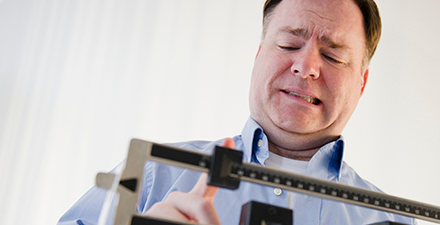Physical Therapy Guide to Obesity
Obesity is a chronic disease in which excess body fat worsens health. A person who is obese has an increased risk for chronic conditions. These include high blood pressure, heart disease, stroke, diabetes, depression, and some cancers. Obesity can reduce a person's ability to work and do simple physical activities. It is linked to a reduced quality of life and increases the risk of early death. Obesity is a worldwide epidemic. It affects people of all ages, races, and economic levels. Adults are overweight if their body mass index is 25 to 29 and obese if their BMI is 30 or higher. Children are obese if their BMI is at or above the 95th percentile on BMI-for-age growth charts. In the United States, more than 42% percent of adults (four in 10) and nearly 20% of children (two in 10) are obese.
Physical therapists treat pain and movement problems that can lead to an inactive lifestyle and obesity. They also help people with obesity achieve the recommended amount of physical activity. Regular physical activity at any age can improve physical and mental health. It also can help people with obesity become healthier.
Physical therapists are movement experts. They improve quality of life through hands-on care, patient education, and prescribed movement. You can contact a physical therapist directly for an evaluation. To find a physical therapist in your area, visit Find a PT.
What Is Obesity?
Obesity is a complex disease in which the body stores excess fat. It can result from:
- Certain health behaviors.
- Environmental and cultural factors.
- Family history (genetics).
It is important to balance calories from foods and drinks with the number of calories used for physical activity to prevent excess weight gain. Finding a balance is not easy. Today’s world promotes overeating and an inactive lifestyle. Large portion sizes of high-calorie, low-cost foods are easy to access. Also, changes in technology and society linked to low physical activity have resulted in a drop in:
- Walking in favor of driving.
- More sitting and less standing while working.
- More seated activities, such as watching television and playing video games.
While families cannot change their genetics, they can encourage healthy eating and physical activity.
A physical therapist can help you prevent or manage obesity and related health problems such as:
- Cardiovascular (heart) disease.
- Stroke.
- Diabetes.
- High blood pressure.
- Cancer (breast, liver, uterine, prostate, and colon).
- Osteoarthritis.
- Lymphedema (swelling of the arms and legs).
- Breathing problems, including asthma and sleep apnea.
- Depression.
- Sleep apnea.
- Falls.
How Does It Feel?
Obesity can make it hard for people to do common everyday activities. For example, a person with obesity may have trouble walking, climbing stairs, or doing chores at home. If you are obese, you may experience:
- Fatigue when doing simple daily activities.
- Joint pain, especially in the legs and back. This is due to increased stress on the joints and muscles of the body and not getting enough movement.
- Trouble walking, climbing stairs, or playing physically active games.
- Frustration or depression about not being able to lose weight.
How Is It Diagnosed?
If you see your physical therapist first, your physical therapist will conduct a thorough evaluation that includes taking your health history. Your physical therapist will also ask you detailed questions about your condition, such as:
- Do you have any joint pain?
- Do you have difficulty with any daily activities?
- How much daily exercise do you get?
- Do you have any other medical conditions or problems?
- Do you take any medication for your obesity or any other condition?
- Have you had any surgery related to your obesity?
- Are you under the care of a physician?
- What are your goals?
Your physical therapist will perform tests, such as motion, strength, coordination, and balance checks to help assess your overall physical ability. Your physical therapist may also perform specific obesity tests, such as calculating your BMI, or measuring your waist circumference, "skinfold" thickness, or percentage of body fat.
Your physical therapist may consult with your physician or other health care providers about your condition, who may order further tests to rule out other medical conditions that may affect the type of physical therapy you receive.
How Can a Physical Therapist Help?

Physical therapists use the latest evidence to design treatment programs for your specific needs and goals. Working with a physical therapist can help you:
- Manage your weight and prevent obesity.
- Develop a program to address problems that may impact your ability to be active. Your physical therapist can teach you fun, pain-free ways to exercise.
- Safely progress your physical activity level. The right kinds and amount of exercise are important.
Your physical therapist will conduct a full evaluation. This will include taking your health history. They may ask you detailed questions, such as:
- How much daily physical activity do you do?
- Do you have difficulty doing any daily activities?
- Do you have any joint pain?
- Do you have any other medical conditions or problems that make physical activity difficult?
- Do you take any medicines for obesity or another condition?
- Have you had any surgery related to your obesity?
- Are you under the care of a physician?
- What are your goals?
Your physical therapist will perform tests to check your overall fitness. These tests will assess your:
- Movement.
- Strength.
- Coordination.
- Balance.
Your physical therapist also may perform specific obesity tests to:
- Calculate your BMI (based on your height and weight).
- Measure your waist and skinfold thickness.
- Find your body fat percentage.
Your physical therapist also may work with your doctor or other health care providers. Your doctor may order further tests to rule out other medical conditions.
Your physical therapist will work with you to improve your strength. They also can help you improve your aerobic capacity (ability to convert oxygen to energy during exercise). Both aerobic and strengthening exercises help with weight loss and weight control. Physical therapists create safe, effective physical activity programs to help people of all ages and abilities. They can help you achieve the recommended amount of physical activity. Starting a fun exercise routine can help you make better choices about your diet.
Physical therapists also can address the key reasons for unhealthy behaviors. They can help you:
- Identify and overcome barriers to physical activity.
- Develop healthy habits.
- Set personal goals.
- Form healthy habits to help you stick to your program.
Your physical therapist treatment program will include working with you to:
Reduce pain. Your physical therapist can teach you safe ways to do activities with the least amount of pain. Moving more can help relieve pain. Your physical therapist will develop a program to help you move more.
Improve cardiovascular fitness. Your physical therapist will design a heart-healthy aerobic exercise program for you. This program will improve your metabolism (the process of getting energy from food). It also will help you burn more calories. Physical therapists help adults, children, and people with disabilities do aerobic activities at their comfort level.
Improve strength. Your physical therapist will teach you exercises to address muscle weakness or improve your strength. Building muscle strength helps to:
- Burn calories.
- Make daily activities easier.
- Relieve joint pain.
Gentle and low-impact resistance training (using elastic bands) can help you avoid joint stress.
Improve movement. Your physical therapist will choose specific activities and treatments to help restore the normal movement of stiff joints. These might begin with passive motions that your physical therapist performs for you. Then, you will progress to active exercises that you do yourself.
Improve flexibility and posture. Your physical therapist will determine if any of your major muscles are tight. They will teach you how to gently stretch any tight muscles. Your physical therapist also will assess your posture. They will teach you exercises to improve your ability to maintain proper posture. Good posture can make doing hard activities easier and less painful. It also can improve your breathing.
Increase activity levels. Your physical therapist will discuss your activity goals with you. They will design a safe treatment program to address your specific needs to help you reach your goals in the fastest, most effective way possible.
If Surgery Is Necessary
Some patients have bariatric surgery (such as gastric bypass) to treat severe obesity. Your physical therapist can help you prepare for and recover from surgery.
Your physical therapist will:
- Guide you through each session.
- Help you prevent injury to your joints and muscles.
- Adjust your program as needed.
Programs before surgery often involve strength training and aerobic conditioning.
Programs after surgery often start with gentle deep breathing and lower body (legs, ankles, feet) exercises. When it is safe, you will progress to strength and aerobic training. Your physical therapist will help you after surgery to:
- Minimize pain.
- Regain motion and strength.
- Return to normal activities as soon as possible.
Can This Injury or Condition Be Prevented?
It is important to follow nutrition and physical activity guidelines to help prevent obesity. Consider the following:
- Get moving! Add activities you enjoy to your daily routine and avoid too much sitting.
- Avoid watching TV for more than two hours per day.
- Do not use a computer longer than one hour without a physical activity break.
- Use your body as much as you can to walk, climb stairs, garden, clean, wash dishes by hand, and other daily activities that keep you moving.
- Learn proper nutrition and portion sizes to help control your calorie intake.
- Do at least 30 minutes (adults) or one hour (children) of physical activity (such as walking) daily. This advice applies to people with disabilities as well as those with most chronic medical conditions. Always check with your physical therapist or a health care provider before starting any exercise program.
- The Physical Activity Guidelines for Americans, 2nd edition recommends that older adults do 150 minutes of moderate-intensity aerobic activity a week. People with chronic conditions should be as physically active as their abilities and conditions allow.
- Each week, older adults should do several different types of physical activity, including those that focus on:
- Balance training.
- Aerobic capacity.
- Muscle strength.
Your physical therapist will prescribe a home-exercise program specific to your needs to help you:
- Improve or maintain strength and flexibility.
- Manage your weight.
- Prevent future injuries.
What Kind of Physical Therapist Do I Need?
All physical therapists are prepared through education and experience to treat obesity and related muscle and joint problems. However, you may want to consider:
- A physical therapist who is experienced in treating people with orthopedic injuries. Some physical therapists have a practice with an orthopedic or sports medicine focus.
- A physical therapist who is a board-certified clinical specialist, or who completed a residency or fellowship in orthopedic or sports physical therapy. This therapist has advanced knowledge, experience, and skills that may apply to your condition.
You can find physical therapists in your area with these credentials and clinical expertise on Find a PT, a tool built by the American Physical Therapy Association.
General tips when you are looking for a physical therapist (or any health care provider):
- Get recommendations from family, friends, or other health care providers.
- When you contact a physical therapy clinic for an appointment, ask about the physical therapists' experience in helping people who are overweight or obese.
- Be prepared to describe your symptoms in as much detail as possible during your first visit. Make a note of what makes your symptoms better or worse.
The American Physical Therapy Association believes that consumers should have access to information to help them make informed health care decisions and prepare them for a visit with their health care provider.
The following resources offer some of the best scientific evidence related to physical therapy treatment for obesity. They report recent research and give an overview of the standards of practice both in the United States and internationally. They link to a PubMed* abstract, which may also offer free access to the full text or to other resources. You can read them or print out a copy to bring with you to your health care provider.
Centers for Disease Control and Prevention. Physical activity for a healthy weight. https://www.cdc.gov/healthyweight/physical_activity/index.html. Accessed June 1, 2021.
US Department of Health and Human Services. Physical Activity Guidelines for Americans. 2nd ed. https://health.gov/sites/default/files/2019-09/Physical_Activity_Guidelines_2nd_edition.pdf. Accessed June 1, 2021.
Pazzianotto-Forti EM, Moreno MA, Plater E, Baruki SB, Rasera-Junior I, Reid WD. Impact of physical training programs on physical fitness in people with class II and III obesity: a systematic review and meta-analysis. Phys Ther. 2020;100(6):963–978. Article Summary in PubMed.
Bennie JA, De Cocker K, Pavey T, Stamatakis E, Biddle SJ, Ding D. Muscle strengthening, aerobic exercise, and obesity: a pooled analysis of 1.7 million US adults. Obesity (Silver Spring). 2020;28(2):371–378. Article Summary in PubMed.
Gao F, Zheng KI, Wang XB, et al. Obesity is a risk factor for greater COVID-19 severity. Diabetes Care. 2020;43(7):e72–374. Article Summary in PubMed.
Barrow, DR, Abbate LM, Paquette MR, et al. Exercise prescription for weight management in obese adults at risk for osteoarthritis: synthesis from a systematic review. BMC Musculoskelet Disord. 2019;20(1):610. Article Summary in PubMed.
Sabbahi A, Arena R, Woldt J, et al. Improvements in cardiometabolic risk markers, aerobic fitness, and functional performance following a physical therapy weight loss program. Physiother Theory Pract. 2018;34(1):13–21. Article Summary in PubMed.
Hansen D, Hens W, Peeters S, et al. Physical therapy as treatment for childhood obesity in primary health care: clinical recommendation from AXXON (Belgian Physical Therapy Association). Phys Ther. 2016;96(6):850–864. Article Summary in PubMed.
Racette SB, Deusinger SS, Deusinger RH. Obesity: overview of prevalence, etiology, and treatment. Phys Ther. 2003;(83):3:276–288. Article Summary Not Available.
*PubMed is a free online resource developed by the National Center for Biotechnology Information. PubMed contains millions of citations to biomedical literature, including citations in the National Library of Medicine's MEDLINE database.
Expert Review:
Jun 13, 2021
Revised:
Jun 13, 2021
Content Type: Guide
Obesity
PT, DPT
Colleen Hergott
PT, DPT, board-certified clinical specialist in geriatric physical therapy
Gina Pariser
PT, PhD
Kenneth L. Miller
PT, DPT, MA, board-certified clinical specialist in geriatric physical therapy on behalf of APTA Geriatrics, an Academy of the American Physical Therapy Association
You Might Also Like...
Patient Stories
Man Who Lost 300 Pounds Credits Physical Therapist With Transforming His LifeJul 28, 2021
Scott was was 50 years old, 520 pounds, and depressed. He found hope and better health through physical therapy.
Did You Know?
Physical Activity Prevents Disease and Increases Life ExpectancyApr 14, 2021
A study in the British Journal of Sports Medicine highlights the major public health problems linked to physical inactivity. The findings stress the importance
Did You Know?
Physical Activity Plays a Greater Role in Obesity Than Caloric IntakeFeb 12, 2015
Physical activity, not caloric intake, is the bottom line for your waistline. This news is from an American Journal of Medicine study, "Obesity, Abdominal


